I’m going to share how I fixed a P0121 on a VW Tiguan 2.0 TDi by cleaning the throttle valve.
The engine light wasn’t on, but I found the code whilst fixing the boot latch. As you’ll see from what I found, it was only a matter of time before this would trigger the engine light.
The vehicle is a 2012 VW Tiguan 2.0 TDi DSG 4Motion with the CFFB engine and about 83,000 miles. It doesn’t do many long journeys.

I’ve worked on a few VWs and Audis over the years, so use VCDS as my diagnostic tool for VAG cars.
Tools required
- T30 Torx bit and driver.
- 10mm spanner.
- Lots of clean rags or paper towels.
- Solvent for cleaning.
- Blunt screwdriver or other similar tool for scraping debris.
- Code reader.
Removing the throttle valve
As with much engine bay work, the first step is to remove a load of plastic gubbins out of the way. The engine cover is removed by pulling upwards.
I removed 2 parts of the air cleaner ducting to improve access: these being the cold air inake and the U shaped pipe linking this to the airbox. These just pull apart, although this can be made easier by pushing in the lock tabs holding the pieces together.
The next step was to undo 3 x T30 Torx bolts holding the throttle valve in place and detach the dipstick support bracket (the dipstick and tube can stay in place).
Unplug the connector, using a small screwdriver or plastic pry tool to lift the connector tab. I disconnected the battery negative terminal beforehand.
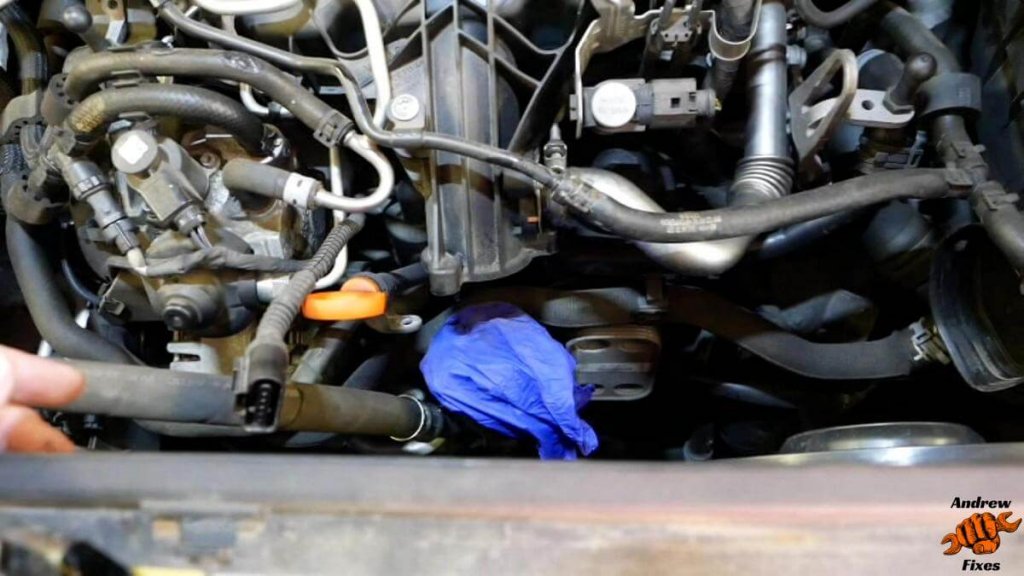
I put a clean glove over the end of the intake pipework, to prevent anything being dropped in there.
As soon as I removed the throttle valve, I felt there was a good chance I’d found the cause of the P0121 on the VW Tiguan: loads of carbon deposits inside the valve! The hypothesis being that the carbon on and around the throttle flap stops it from moving freely. This means the ECU gets an implausible signal from the throttle position sensor from time to time, since the flap isn’t in the position ‘expected’ by the ECU and reported by the sensor.
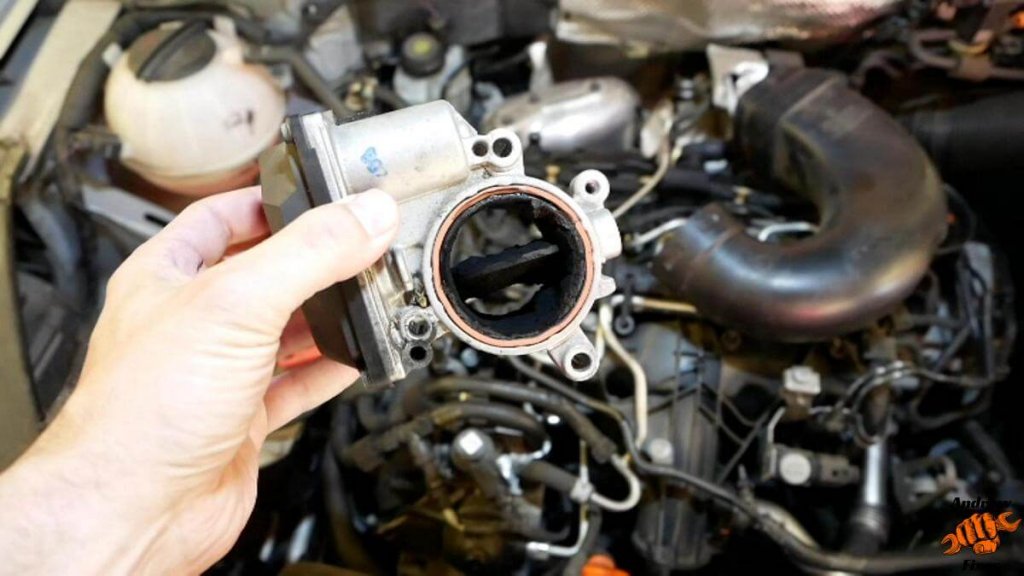
Obviously there is no certainty at this stage that cleaning the valve will solve the problem. The carbon deposits were sufficient to stop the throttle butterfly moving through its full range, so I felt it was worthwhile going ahead with the cleaning before embarking on any further diagnostic work. It’s possible you could do all this cleaning and not solve the problem, although I’d expect the engine light to be on in the case of an electronic failure in the valve motor or throttle position sensor.
Cleaning the throttle valve
This is a horrible job! I did it outside with gloves on, and worked on some cardboard that I could throw away afterwards. I also wore a mask to minimise inhalation of fumes from the solvent used for cleaning.
To start with I scraped the worst of the clag off with a blunt screwdriver (blunt so as not to score the throttle valve housing or plate).
Next I used Wynn’s diesel EGR extreme cleaner (part number 23379). Like many products of its type, most of the instructions are about spraying it into the intake with the engine running to clean the EGR valve. However it is also designed for direct application to carbon deposits on intake components.

It took a while, but I’m not surprised given the level of carbon deposits on the valve. Eventually I was left with a lovely clean throttle valve. I was glad I’d got 2 cans!
Refitting the throttle valve
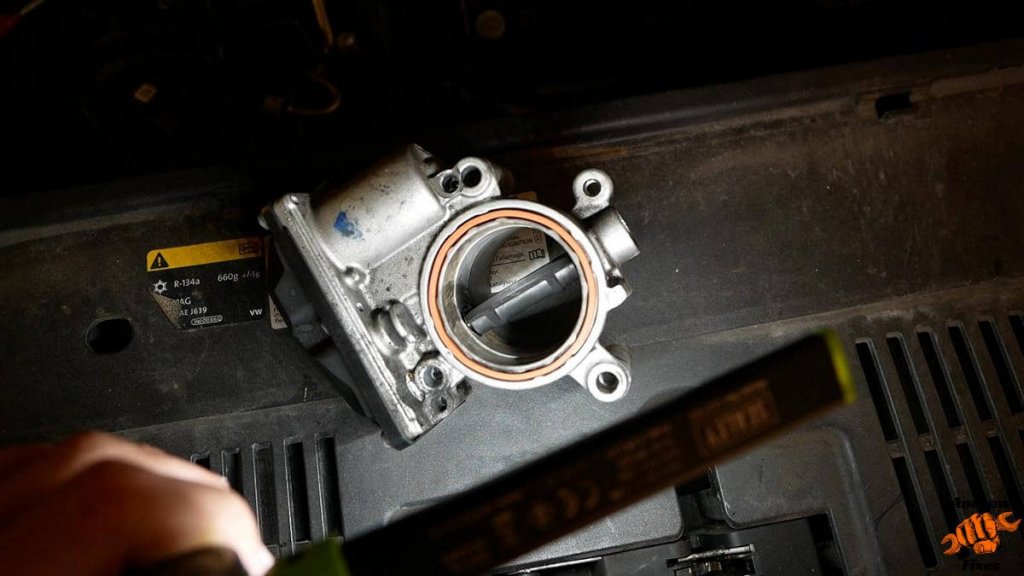
This is a straightforward reversal of the removal process. I used a new gasket from Elring (part number 006.070).
Deleting the P0121 from the VW Tiguan
Having put everything back together, it was time to go back to VCDS and delete the P0121 code from the Tiguan. By the way, you don’t need VCDS to do this job. It’s a great piece of kit for detailed diagnostics and repairs, but for this any standard OBD2 code reader would have been sufficient.
I deleted the code and started the engine. Everything was fine and the code didn’t come back. Always a good feeling!
Test drive!
I noticed the improved throttle response immediately on the test drive, and the acceleration felt a lot more brisk than before the repair. Making a real improvement in the driving experience was even more rewarding than getting rid of the code.
I did another code scan to check the code (or any others) hadn’t appeared after the test drive. It hadn’t, so good news!
The Tiguan owner was really impressed with the improvement, and was particularly pleased to see improved fuel economy after the throttle valve cleaning.
As a final note, there is an argument that the EGR valve should be cleaned too, because if the throttle valve is like this one was, it’s likely the EGR valve is too. I didn’t clean the EGR valve this time, but acknowledge it would be ‘best practice’ to do so.
I’ve also advised the owner to sell the car! That might seem a bit excessive, but this engine isn’t (and diesel engines in general aren’t) best suited to lots of short journeys with no long journeys.
Video
Here is a video of me working on the car:

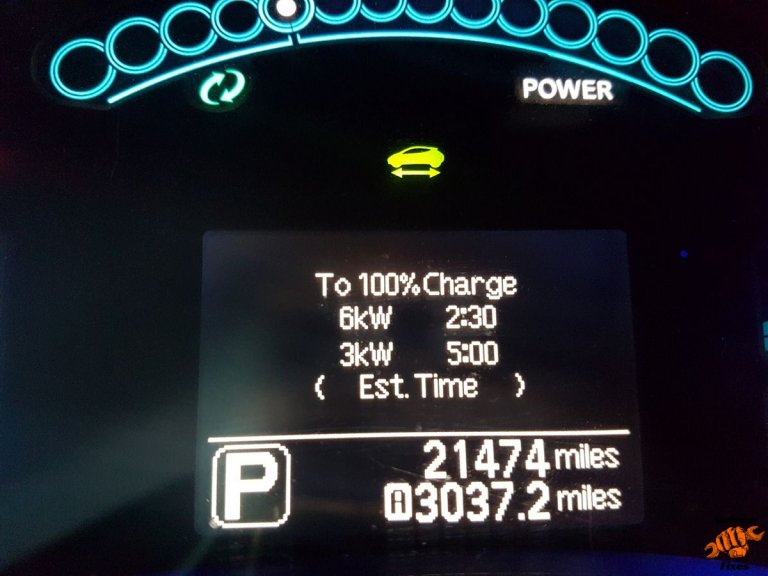
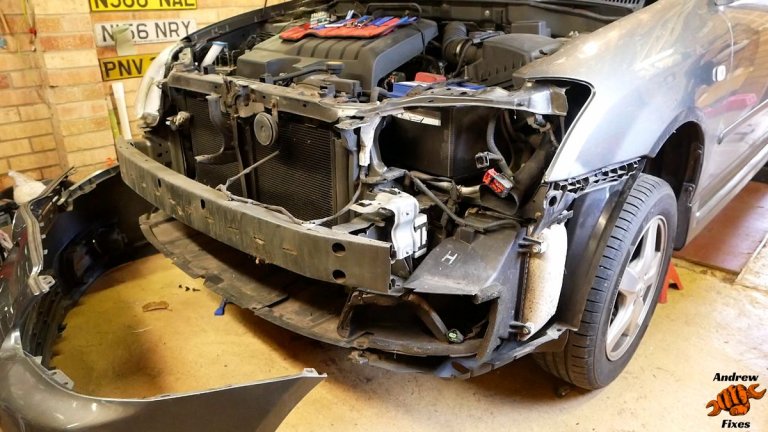

Hi Andrew,
Great video. I have the same fault code and was under the same conclusion that the throttle valve is clogged up. After the clean up, did the fault reappear?
Thanks Rob!
The car has done about 2000 miles since I did this repair and the fault code hasn’t reappeared.
Hope you manage to get yours sorted.
Andrew
When the throttle valve was reinstalled, did you use VagCom to relearn the throttle valve values?
No, that wasn’t necessary for this car. I think the relearning process is more for petrol engines with throttle bodies.
Hi Andrew, thanks for this guide. I have a 2014 2.0TDI 140 Tiguan with the same issue and code although the only thing I’ve been noticing are stop start errors and rougher shutdowns.
How did you manage to access the circlip bolts that held the rubber hose together? The intercooler/radiator pipe is awkwardly in the way and the gap between the fan and bolt makes putting a spanner, ratchet and even screwdriver in a challenge as well, so am curious as to how you (or VW when they put this together) managed it!
Hi Marvin
I wish I’d recorded the entire process! I only undid the clamp at the top end of the intercooler hose and this was sufficient to allow removal of the throttle valve. I did remove some of the air intake ducting to improve access.
I’d have used a small 1/4 inch ratchet and socket to undo the clamp, either with a long extension or none at all – unfortunately I can’t remember the orientation of the clamp bolt.
The VW factory manual says the entire intercooler pipe should be removed but this definitely wasn’t necessary in my experience.
This vehicle had a CFFB engine code so if yours is different, the above may not apply.
Best wishes for getting yours fixed!
Andrew
Thanks Andrew – this Tiguan is also a CFFB thankfully, albeit with 92000 miles! I managed to detach the top end of the hose in my first attempt but decided to stop in case I’d damage anything. Had another go after seeing your response and whilst access was a challenge (finding a tool small enough to turn in the gap for that bottom bolt placed directly behind the hose) once loosened the bolts were able to be loosened by hand.
Lo and behold I had the same if not more soot on my valve (being on 92k and I’d been informed prior to ownership by the family member that he had been getting the engine light and glowplug light and having stop-start errors whereby the car had to be restarted manually since 75k miles).
I also removed the EGR nozzle for cleaning (involved removing the EGR pipe which was much easier than the throttle body!) and this was also coked up. Is that what you were referring to in your ‘Test drive’ section? I understand the EGR valve itself is tricky to access and requires underbody access to remove, but the EGR feed pipe to the intake manifold and accompanying nozzle are quick to remove using T30 for the mounting bolts and 5mm Hex for the nozzle/pipe clamp.
Thanks for the recommendations for the Wynns EGR cleaner – I used a slightly different combination of 1 can Wynns Extreme EGR (200ml) and 1 tin of Holts EGR & Carb cleaner (500ml). Main difference was that Holts was less than a third of the price at around £3 from ECP yet over twice the amount of solvent! Hard to tell which was more effective as I was alternating between the two and was naturally more liberal with Holts being a fraction of the price, but I would imagine Holts can achieve same results even if weaker given the quantity and price!
Car is now shutting down smoothly and the minor lurching when coming off the accelerator in 1st/2nd and uneven engine braking effect I had when going downhill with partial accelerator has gone. I would stress that the lurch/engine braking would be hard to notice by most non-car geeks and perhaps even garages that are time limited with the number of service/MOT backlogs they’re having to deal with currently.
May I ask where you obtained the factory manual?
Really pleased to hear you managed to fix it and make a difference to your car. Thanks for the tip about the Holts cleaner. I use Holts brake cleaner and that’s pretty good.
The manuals can be downloaded here. You have to pay for time-limited access to download them, but quite a few pages can be downloaded in an hour and it isn’t very expensive.
My tip for a small tool for jobs like this is the Facom R.180 compact ratchet and extension with a suitable T30 bit.
Cheers
Thanks very much Andrew. I was also getting the P0121 error code and I found your instructions, photo’s & video very useful when I cleaned my valve up yesterday – 2013 Tiguan 65k. It was pretty clogged up and the valve wasn’t opening fully. Pre-pandemic the car would be getting at least one 200 mile round trip every week, but that’s changed and it’s just used for short trips at the moment, which doesn’t help.
I think you missed a few choice words out of your description though, particularly when it came to getting at the lower Jubilee clip of the hose, as someone else has already mentioned. I turned it around when I put it back together, so it’s easier to get to in the future.
I had to get a gasket from the £ealers, £16.97! due to time constraints and used most of one can of PMA Carb Cleaner, £4.99, recommended by my local independent car spares shop, which worked well. Diagnostic tool from a well-known online retailer, as I could get it the next day (Model YA-101) for about £24.00.
The code was coming back shortly after being reset before I cleaned the valve, but not since. I’ve done about 50 miles after cleaning it up, so looking good and the car’s running better.
Total spend around £46, but I can use the diagnostic tool again. A good saving when compared with taking it to a garage.
Thanks again Andrew, very useful! now, about cleaning the EGR!?
Thanks for the feedback Mike, and for sharing your experience of doing the cleaning.
I’ll do a write up on the EGR valve if / when I need to clean it. There will definitely be some choice words for that job!
Cheers
Andrew
I had this same problem so I removed the body, cleaned it and re-assembled it. after about a month the same fault code has popped up again. I’m thinking the sensor is faulty.